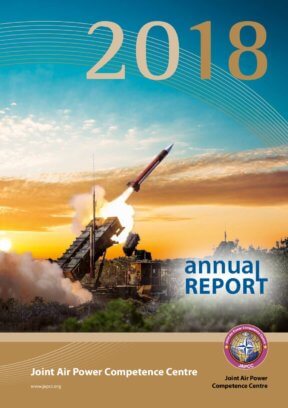Foreword
Our defensive Alliance of 29 nations is the most powerful in human history. Despite this, NATO faces a threatening, unpredictable and opaque security environment that affects us beyond the borders of the North-Atlantic Area.
In an unpredictable world, with a wide range of challenges and opportunities, NATO is determined to protect and defend our indivisible security, our freedom and our common values.
At the 2018 Brussels Summit, and in other forums, our nations decided to continue to ensure that NATO has the full range of capabilities and forces that are trained, interoperable and deployable.
With respect to the nature and extent of our engagement, we can say that the number of activities in which we are engaged has increased, and Allies continue to make valuable force and capability contributions that benefit the security of the Euro-Atlantic area through NATO’s operations.
It is in this context that the JAPCC has stepped into the gap of the identified capability shortfall areas to provide assistance across a wide range of air and space power challenges. The JAPCC acts as a catalyst for the improvement of NATO´s air and space power by providing insightful ideas and effective solutions to the Alliance.
As we have in the past, , the JAPCC continues to work at the forefront of major technological issues facing NATO, demonstrated by one of this year’s projects ‘Future Battlefield Rotorcraft Capability Anno 2035 and Beyond’. This project provides an independent analysis regarding the necessary requirements for a future military-rotorcraft capability in support of future NATO rotary-wing operations in 2035 and beyond.
Another outstanding example for JAPCC´s value to NATO was the development of a new, and more comprehensive set of metrics to encompass all required operational and enabling components of Joint Air Power capabilities. In July 2018, the Defence Planning and Policy Committee endorsed the Military Committee’s advice to include these new Air Level of Effort metrics in the Political Guidance 2019, once again demonstrating the value of JAPCC advice to key decision-makers of our Alliance.
In addition, the JAPCC continued to provide Air & Space power expertise to several NATO Command-level exercises. JAPCC’s role during these exercises is to provide highly dynamic and realistic Opposing Forces (OPFOR) Air, Space and Cyber-space interaction. Our specialists’ involvement brings a depth of knowledge and responsiveness that would otherwise be missing. This support heightens the training audiences’ interaction with the exercise itself providing a challenging and realistic environment in which to learn.
JAPCC´s 2019 Programme of Work continues to focus on supporting the evolution and transformation of Allied Joint Air and Space capabilities with an eye always towards increasing interoperability. Key areas of effort in the coming year include: Space, Air and Missile Defence, Air Command and Control, Electronic Warfare, Joint ISR, Force Protection, Unmanned and Rotary Wing capabilities, and more.
Over the following pages, this JAPCC Annual Report will highlight the key developments, projects and research that shaped Joint Air and Space Power in 2018 and which will continue to do so in the future. I encourage each of you to take a few minutes to review this document and to contact us with questions, feedback or requests for support at any time.
Tod D. Wolters
General, USA AF
Director, JAPCC









